Bachelor Thesis - Computer Graphics Group
Bachelor Thesis - Computer Graphics Group
Bachelor Thesis - Computer Graphics Group
Create successful ePaper yourself
Turn your PDF publications into a flip-book with our unique Google optimized e-Paper software.
The goal of the gesture recognition algorithm is to determine, which gesture<br />
pattern, if any, corresponds to the given gesture. As already defined in the Introduction,<br />
the program treats gestures as directed sequences of mouse cursor<br />
positions, represented by vectors of points. The time span between the individual<br />
movements is not considered significant and therefore is not taken into<br />
account. As it was observed in [2], gestures are expected to be simple shapes,<br />
which can be drawn on the screen easily, in order to be useful. It should be<br />
possible to repeat them multiple times with sufficient similarity. Suitable gesture<br />
patterns include straight lines, simple geometric shapes such as triangle,<br />
circle, square, etc., letters of the alphabet, which can be painted with a single<br />
stroke.<br />
The output of the algorithm is a regular gesture, identified by the name of<br />
the corresponding pattern. Patterns are defined by their base shape, mainly<br />
used by the user interface for graphical representation. However, user entered<br />
samples assigned to each pattern are more important. They are crucial for<br />
successful gesture recognition, as the variable shape and size of the performed<br />
gestures cannot be expressed by a single definition. In case there are not<br />
enough pattern samples present, it is possible to emulate them by adding<br />
noise to the base pattern shape. However, this trick is unable to substitute<br />
real, user-entered samples.<br />
We decided to search for a suitable gesture recognition algorithm, instead of<br />
taking the risk of failure, while trying to invent a completely new solution, and<br />
to avoid reinventing the wheel. Several different sources have been consulted.<br />
However, most of the papers deal with different kinds of gestures, such as hand<br />
gestures. The results of the research done in [2] are the most interesting. The<br />
algorithm proposed in this paper is simple, yet powerful. Hence, our solution<br />
will be based on this algorithm.<br />
2.1 Algorithm principle<br />
The algorithm consists of two separate phases: preprocessing and classification,<br />
as outlined in figure 2.2.<br />
raw sequence<br />
of points<br />
preprocessing<br />
normalized<br />
input<br />
Figure 2.2: Recognition process overview<br />
classification<br />
The purpose of the preprocessing phase is to produce appropriate input for the<br />
actual gesture classification. The length of the raw sequence of points varies<br />
from gesture to gesture. Therefore, the input has to be transformed into a<br />
12
















